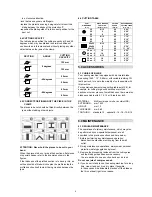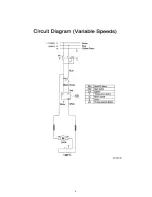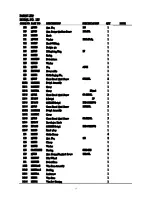
Try not to damage the frame as you may have to move
the machine long distances or store it for long
periods.
2.2 HANDLING (Fig.2)
As the machine is not heavy (Kg 16), it can be
lifted and moved by a single person by gripping it
from the machine body (5), duly clamped (see pint 2.3)
2.3 TRANSPORT (Fig.2)
It is necessary to low the saw body till the lower position
and fix it to the base : it is sufficient to insert the pin
U
in
the hole in the body , then lift the machine, gripping it as
showed in Fig.2.
For transport the machine, it is better to place it in the box
it was when purchased.
Ensure it is placed in the correct position indicated by the
arrows on the packaging.
Pay careful attention to the ideogram printed on the box as
they provide all necessary information for palletization and
stacking of boxes.
Tying the load down with ropes or safety belts is
raccomended during transportation to prevent the load
from sliding or falling.
2.4 POSITION/WORK STATION (Fig.3)
Place the machine on a sufficiently flat workbench so that
the machine has the better possible stability.
In respect of ergonomic criteria during cutting operations,
the workbench must be positioned at such a height that
the clamp level is between 90 and 95 cm from the ground
(see fig.3)
ATTENTION: Make sure that the machine is placed in a
working area with suitable environmental conditions
and lighting. The general conditions of the working
environment are of fundamental importance for
accident prevention.
2.5 ELECTRICAL CONNECTIONS
Check that the mains to which the machine is connected is
earthed in accordance with current safety regulations and
that the power point is in good condition.
Remember that there should be a magnetothermic
protective device fitted upstream of the mains to protect all
the conductors from short circuits and overloads.
This protective device should be selected according to the
electrical features of the machine listed below:
Nominal voltage ................................. 1~,115 / 230V
Nominal frequency ............................. 50/60Hertz
Max programmed absorbed value ..... 3.8Ampere
Nominal input power .......................... 1250Watt
Power factor....................................... 0.93
Nominal speed ................................. 14.000-19.000rpm
Insulation ........................................... Class B
Type of service................................... intermittent S4-60 %
In case of power failure in mains, while you wait for power
to be restored there is no danger hazard may arise: in face,
the electronic governor
O
or main switch
D
is also
equipped with a reset function which prevents the machine
from restarting automatically. ..............................................
The motor of your sawing machine (electronic version)is
equipped with a protective heat circuit breaker which
interrupts the power supply when the temperature of the
coils rises too high.
When the power supply is interrupted, wait for normal
reset.
3.0 ADJUSTING (Fig. 4-5-6-7-8)
3.1 TENSION OF THE BLADE (Fig.4)
Turn the handwheel
B
in a clockwise direction until it
locks.
If the tension is too high, the blade tends to escape
from the guide. In this case, slacken the blade tension
by turning of one/two turns the handwheel B in a anti
clockwise direction.
3.2 BAR STOP (Fig.5)
Use the bar stop supplied if you have to do several cuts on
pieces of the same length.
In this way you do not have to repeat the same
measurement each time.
Screw rod
E
into the hole of the base and fasten it with
nuts
F
. Slacken the handwheel
G
and place the stop
L
at
the correct distance from the blade. Tighten handwheel
G
again.
3.3 Cutting angle (Fig.6)
The band saw can cut at an angle varying from 0 to 45
degrees : it is sufficient to slacken the handle
I
and turn
the swiwel support
J
towards the respective limit stops
H
and
K
.
For all intermediate angles, turn the swiwel support
J
until
the mark
M
on the support matches the corresponding
position on the plate.
Then lock the rotating support
J
again.
3.4 CUTTING SPEED (Fig.7)
Two speed version
Depending on the type of material and its section (see
CUTTINGTABLE) you can choose two different cutting
speed 60 or 80 m/min. by means of the switch
N
.
Electronic version
Your sawing machine is equipped with CESC (Constant
Electronic Speed Control), which allows gradual and
continuous variation of the cutting speed , adapting it to
the type and dimension of the material to be cut (see
cutting table).
To select the most suitable speed, use the speed control
knob
O
to increase or decrease the speed as you require.
Example:
Stainless Steel: 30m/min. position 1
Common Steel: 40-60m/min. position 2-3-4
Allum.Alloy: 80m/min. position 6
Pipes/sections: 70-80m/min position 5-6
4






































